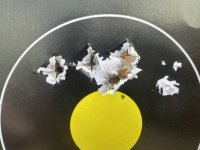Winchester model 70 in .222 Rem If the barrel is still factory (twist rate of 1-14" should be norm)
With a 1-14" twist I personally think selection of a bullet longer than a 50-55gr lead flat base bullet will result in keyholing .
You could do a ladder test (load 1 round ea in 0.3grs increments) to find accuracy nodes. Preferably at 400yards, Some claim as close as 200 Yards can be used. But I think it's way to close of a distance to catch the nodes and would / has a good possibility to give a false positive.
What is the length from rim to the ogive tip of your selected projectile when it makes contact, and the bolt closes once you get that length subtract 0.020" (this establishes the SAFE COAL for your rifle and that bullet from that vendor) use that length to ladder test for every round.
IF you have a bullet comparator it would not be bullet specific. Personally I don't have one (yet) so I measure true COAL and have to use THAT 1 bullet for measuring and die setup. The speer TNT shoots well, very well in my slow twist rifles and is really consistent in length from base to tip.
Example
part2
FINDING JAM Point <<<<< hyper link
remember to slightly lube the ogive of the dummy round before closing the bolt so as to not stick the bullet in the barrel.
If he doesn't cover the selection of nodes from a ladder test and adjusting seating depths look over his channel.
Hopefully those three videos will help you. (watch them at least twice, for it to soak in. The principle is so simple and as humans we for some reason make it hard.)
Erik Cortina won the world championship in F-class, I've been loading for 50 years, and his advice is pretty solid in my opinion. Others will disagree.
Look for two nodes if available with the selected powder in the test before adjusting bullet seating depth for any node. It's not uncommon to have only 1. But two nodes is better
The purpose of a ladder test is to save components and time.
I think I would try the Speer 50gr TNT (#1030) and you said you had TAC? good powder. (my go to choice is H335 for the 223 family, and Have had good luck with TAC as well)
so a ladder with TAC and a 50 grain would look like this (load 1 round each at the JAM length - 0.020" or - 0.028" aka Max safe length ). OBSERVE for pressure as you shoot. Start with lowest to Highest if you see pressure signs from the case after shot STOP
1. 21.2grs
2. 21.5grs
3. 21.8grs
4. 22.1grs
5. 22.4grs
6. 22.7grs
7. 23.0grs
8. 23.3grs
9. 23.6grs (here is where Hodgen says upper limit is, if no sign of pressure you could go on until you do see pressure signs)
10. 23.9grs If your brave. (it's not uncommon for some of my bolt guns to be higher than suggested to be higher than the load data. But when I change Lot #'s I retest)
so say shot #4,5,6,&7 are really close.
shot 1,2,&3 are close , I would use the node that shot 4,5,6,7 gave me 22.1 to 23.0 . doing math I would take 23.0-22.1 = 0.9 divide by two add 22.1grs which would give me 22.5grs (round down)
Fire a 5 shot group measure (if you desire a three shot groups use it. I use five shot groups it's preference), fire the next group and so on. Fire slowly it's not a race and should be enjoyable.
load 5 rounds @ 22.2grs, 22.5, 22.8grs shoot those 15 rounds, measure the groups then select the most accurate. Then adjust my bullet seating depths.
Shorten (-0.003") not lengthening, now have I had to lengthen my safe length, only on match rifles. Your's is a varmint gun so the lead /throat should be zero freebore or close to it. So shortening COAL is the way to go this keeps you off the lands and keeps pressure stable.
Some body I know will disagree with me. Fine but that is pretty much how I look for loads when I have access to a 300yard plus Range. YMMV.




